Basic Training
The journey from puppy to finished duck dog begins with teaching the fundamentals and developing five elemental behaviors
The journey from puppy to finished duck dog begins with teaching the fundamentals and developing five elemental behaviors

By Eric Keszler
Before embarking on a training regimen for your retriever, ask yourself this simple question: What is his job going to be? Most hunters would agree that a retriever's basic job is to sit calmly in the blind and bring back birds that have been shot.
Longtime trainer and author Robert Milner puts it this way: "A hunting retriever's job is to enhance your outdoor experience and provide treasured companionship." To do that, he says, "The dog must be steady, calm, and obedient in a high-distraction environment. And in situations where there are multiple birds down, he must bring you crippled birds before dead birds."
That sounds pretty simple. And Milner's whole training philosophy is based on simplicity, relying on methods drawn from classic psychological principles and behavioral theory. Milner started working with retrievers when he was nine years old and has never stopped. After an active-duty stint in the Air Force, he began training and competing with field trial dogs full-time and, in 1972, founded Wildrose Kennels in Grand Junction, Tennessee. In 1980, he published the classic Retriever Training for the Duck Hunter, which outlined how to use standard compulsion training techniques for retrievers.
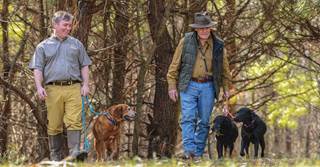
Robert Milner (right), pictured here with his son, Robert Milner Jr., has been training retrievers for decades. His simple methods are based on classic psychological principles and behavioral theory.
Photo John Hoffman, DU
Gradually, Milner became disillusioned with the field trialing culture in the United States. After observing field trials in England, and inspired by "natural" horse trainers like Ray Hunt, he started rethinking his methods. "The traditional way to train dogs was to test and correct," Milner says. "This means that if the dog doesn't do it right, you punish him. It's a backwards way to train."
Milner began breeding British Labs for hunters and exploring the gentler training methods that were being used with horses, dolphins, and many other animals. He sold Wildrose in 1996 and, after 9/11, started training search and rescue dogs using methods based on the psychologist B.F. Skinner's theory of operant conditioning. In 2005, he founded Duckhill Kennels in Somerville, Tennessee, and began applying his new training model to gundogs. He published two additional books, Retriever TrainingA Back to Basics Approach and Absolutely Positively Gundog Training.
These days, Milner and his trainers at Duckhill use these innovative techniques to train hundreds of retrievers for their clients every year. But his methods are so simple that the average hunter can use them to produce a reliable and pleasant gun dog. All it takes is an understanding of positive rewards-based training, which is based on giving a reward (usually a treat or a retrieve) to reinforce desirable behaviors. "As a trainer, you're always correct, because you're rewarding a behavior when you see it," Milner says. "When the dog is not doing what's right, you simply ignore it. That removes most of the punishment from the training program."
Apply these methods regularly and consistently to encourage what Milner calls the "five elemental behaviors," and you'll be well on your way to having the four-legged hunting partner you've always dreamed about.
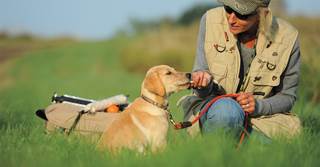
Photo Jim Thompson
These are the basic behaviors a young pup should learn, Milner says. Encouraging and developing them through a system of rewards builds the foundation for all the skills your retriever needs to do his job successfully.
Milner advises starting with a young dog. "The younger they are, the faster they learn," he says. The strategy is to "get it down to the elemental behavior, and repeat it to the point where it's automatic. Repetition strengthens the behavior, and reliability comes from repetition." As the dog learns each behavior, the trainer begins adding distractions. Focus on rewarding the right behaviors and ignoring the wrong ones and "the dog will damn near train himself," he says.
This is one of the easiest behaviors to teach and also one of the most important. During your retriever's puppyhood, around the house and in the backyard, you should frequently call the dog and reward him with a treat when he comes to you. This helps build a positive association between the cue (calling him) and the behavior (coming to you). "Never punish the dog if he doesn't come to you," Milner says. "Just ignore the behavior."
Once he's responding well to this cue, find a large area outside that is fenced or otherwise presents no danger to a loose dog. Call the dog. If he comes to you, reward him with a treat. If he doesn't, stop calling him and start walking away. Keep walking, and the dog will eventually look around and see that you're not there. He'll invariably come to find you. When he does, reward him with a treat. "You have to be somewhat of an actor, and walk away like you really mean it, without looking back at the dog," Milner explains. "The first lesson or two, you might have to walk 30 or 40 yards before the dog comes to you, but by the third or fourth lesson you will be walking only three or four steps."
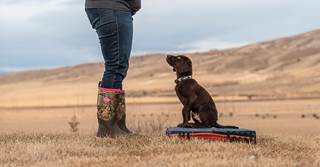
Photo Michael Clingan
A dog that can sit and stay under virtually any circumstance and in the face of distractions will be steady in the blind, even when shotguns are firing, ducks are falling, and other retrievers are working. Milner uses place boards to help with much of the development of this behavior.
"You can start teaching sit as soon as a puppy is eating solid food," Milner says. Begin the lessons at feeding time. Hold the pup's food bowl above his head. He will naturally hold his head up to sniff the food, and, when his neck gets tired, he'll eventually sit. It won't take long, and when he does it, immediately set his food bowl down and let him eat. After doing this at each mealtime over four or five days, he'll begin sitting on his own. At this point, introduce the verbal cue sit.
From there, start using the place board. Get him up on the place board, hold a treat over his head, say sit, and reward him when he does it. Keep practicing this until it's automatic. Then begin delaying the reward, gradually lengthening the time duration of the sit, from half a second to a minute and more. The next steps involve gradually backing away from the pup while he sits, from a quick half-step to several steps. Then begin adding additional distractions, such as the trainer walking around the place board, doing jumping jacks, or tossing retrieving dummies or tennis balls while the pup sits calmly.
This sequence takes place over multiple training sessions. Once the pup is rock steady in the face of all the distractions, you will begin sending the pup to retrieve thrown dummies. "At this point," Milner says, "the retrieve becomes the reward. But only let him retrieve one dummy for every four you throw. The more dummies that you, the trainer, pick up, the steadier he's going to be."
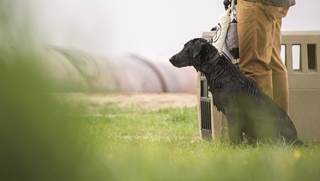
Photo DOUGSTEINKE.COM
This exercise is invaluable in developing a relaxed, steady retriever. It is designed to reward the dog when he is calm, rather than wound up and excited from watching a dummy land in the water. You'll need a chair (for you), place board, check cord, retrieving dummy, and treats. Set up your chair at the edge of a pond, sit the dog next to you on his place board, and attach the check cord to keep him from breaking. Toss the dummy into the water (water retrieves, because of the splash, are more exciting for a dog than land retrieves, Milner notes). Wait a few seconds and try to give your dog a treathe likely won't take it because he is so excited about the dummy. Wait three minutes and try the treat again. This time, because the adrenaline and endorphins in his system have dissipated, he'll probably take it. Once he's taken the treat, send him for the retrieve. The retrieve has become the reward for sitting calmly.
This is the next logical step in your retriever's training, and if you started with sit when he was six or seven weeks old, and stayed consistent with his training, he should be ready for memory retrieves at about 12 weeks old. The memory retrieve is important because you are teaching the pup to go out on a retrieve without the lure of seeing a fall, and it's a natural step toward teaching blind retrieves.
Take the pup out to the place where you're going to drop the dummy. Have him sit, then drop the dummy and walk him back six feet or so. Have him sit again, and then send him for the retrieve. Lengthen the distance gradually over a number of sessions until he's consistently successful at 30 yards. If you increase the distance and he fails, decrease the distance and try again. "A 10 percent failure rate is a good rule of thumb," Milner says. "That tells you that you are challenging the pup enough that he won't get bored, and 90 percent success tells the pup that this is the behavior you want."
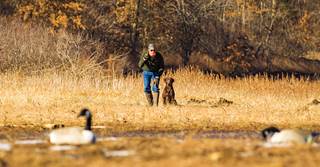
Photo RICKADAIR.COM
In a marked retrieve, the dog sees a dummy or bird fall and "marks" its location. "Throughout his training, a dog shouldn't get any marked retrieves except as the occasional reward for sitting/staying or for stopping and looking on the whistle," Milner says. The fall of a marked retrieve triggers a very powerful primary instinct in dogs. They are exciting almost to the point of intoxication, making it all the more difficult to encourage steadiness, impulse control, and general manners. Throwing mark after mark for your retriever will only make your job as a trainer more difficult.
Is there anything more impressive than a retriever that stops on a dime, mid-retrieve, looks back at his owner, and takes a hand signal to change directions? With proper timing of rewards, it's not that difficult to teach, Milner says.
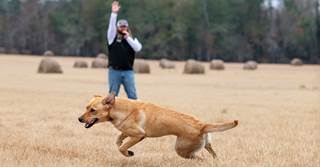
Photo MARK ATWATER/UPCLOSEPHOTO.COM
This behavior is a natural follow-up to memory retrieves, so make sure your dog is solid on those. Start with a 30-yard memory retrieve. Send him for the dummy. When he's on his way, blow your whistle. He probably won't look back at you, but if he does, toss another dummy for him to retrieve (this thrown dummy is more exciting than the memory dummy, so he should head straight for it). If he doesn't look back, wait until he has picked up the original dummy and has taken one or two steps back toward you. Blow the whistle again and throw a dummy. He'll almost always drop the dummy he has and run to pick up the one you just threw. The thrown dummy is his reward for looking at you.
Repeat this sequence. As soon as he stops on his way out to the memory dummy, send him for that dummy with a "back" cast. Eventually he'll start looking at you every time you blow the whistle. As you progress with this skill, you'll want to start introducing distractions and hand signals to the left and right. You can also begin sending him on blind retrieves (he doesn't see where you have placed the dummy). Start your first blind retrieves in the same place where you have been doing memory retrieves. Keep them short to begin with, and try to set them up so he'll be moving into the wind. Gradually add distance.
Retrievers have been selectively bred for years to naturally deliver to hand. They are born with this behavior, and our job is to make sure we don't discourage it. As an example, Milner says: "When your puppy brings you one of your wife's Louis Vuitton shoes, your natural reaction is to punish the dog." But doing so is discouraging a natural behavior that we want to encourage. "The better course of action would be to have a discussion with your wife about where she keeps her shoes," he says.

Photo DOUGSTEINKE.COM
There are a number of other ways we can discourage natural delivery to hand, including too many retrieves in a training session and too many marked retrieves. Also, don't step toward the dog when he is approaching you. Instead, get down on one knee and slip your hand under his jaw to gently remove the dummy from his mouth. And don't ever punish the retriever when he is in close proximity to youin the dog's mind this creates a "punishment zone" around you where he is likely to spit out the dummy.
For dogs that are having trouble with delivery to hand, try this simple and fun drill. You'll need a couple of tennis balls and a retrieving dummy. Toss a tennis ball for the dog. If he brings it back to you, take it and immediately toss the other ball as a reward. If he doesn't bring it back, stop the game and spend a couple of sessions working on recall with treat rewards. Then resume the tennis ball game. Every time he brings the ball to you, reward him with a toss of the other ball. Then toss the retrieving dummy a short distance. When he brings it to you, reward him with a toss of the tennis ball. If he doesn't pick up the dummy, you might need to encourage him by bumping the dummy with your foot and playfully saying fetch. After a few successes he'll get the idea. Milner says the whole process can be completed in about 10 sessions over the course of a week.
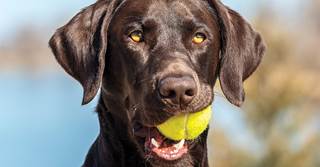
Photo Michael Clingan
Milner recommends these books, by world-class animal trainers, people trainers, and performers, for more insights into rewards-based training.
Ducks Unlimited uses cookies to enhance your browsing experience, optimize site functionality, analyze traffic, and deliver personalized advertising through third parties. By continuing to use this site, you agree to our use of cookies. View Privacy Policy